
Flint is the largest city and seat of Genesee County, Michigan, United States. Located along the Flint River, 66 miles (106 km) northwest of Detroit, it is a principal city within the region known as Mid Michigan. At the 2020 census, Flint had a population of 81,252, making it the twelfth-most populous city in Michigan. The Flint metropolitan area is located entirely within Genesee County. It is the fourth-largest metropolitan area in Michigan with a population of 406,892 in 2020. The city was incorporated in 1855.

Roger & Me is a 1989 American documentary film written, produced, directed by, and starring Michael Moore, in his directorial debut. Moore portrays the regional economic impact of General Motors CEO Roger Smith's action of closing several auto plants in his hometown of Flint, Michigan, reducing GM's employees in that area from 80,000 in 1978 to about 50,000 in 1992.

The Disneyland Resort is an entertainment resort in Anaheim, California, United States. It is owned and operated by The Walt Disney Company through its Experiences division and is home to two theme parks, three hotels, and the Downtown Disney shopping, dining, and entertainment district.

The University of Michigan–Flint (UM-Flint) is a public university in Flint, Michigan, United States. Founded in 1956 as the Flint Senior College, it was initially established as a remote branch of the University of Michigan, offering upper-division undergraduate courses. The institution developed into a fully-fledged university and received accreditation in 1970. Subsequently, the name was changed to the University of Michigan–Flint. It continues to adhere to the policies of the University of Michigan Board of Regents without having a separate governing board.

Metro Detroit is a major metropolitan area in the U.S. state of Michigan, consisting of the city of Detroit and over 200 municipalities in the surrounding area with its largest employer being Oakland County. There are varied definitions of the area, including the official statistical areas designated by the Office of Management and Budget, a federal agency of the United States.
Autoworld, Auto World or AutoWorld may refer to:
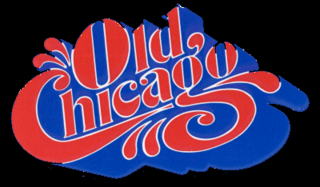
Old Chicago was a combination shopping mall and indoor amusement park that existed in the southwest Chicago suburb of Bolingbrook, Illinois from 1975 until 1980. It was billed as "The world's first indoor amusement park", and it was intended to draw visitors all year round, rain or shine. It opened to great fanfare and over 15,000 visitors on June 17, 1975, with an enormous building that housed major rides, such as three roller coasters and a Ferris wheel, as well as a turn-of-the-century-themed shopping mall with design reminiscent of the architecture of Louis Sullivan, such as his work for the 1893 World's Columbian Exposition in Chicago. However, only six months after opening, the complex ran into financial troubles due to construction cost overruns. The opening of a competing amusement park in Chicago's north suburbs hurt attendance, and the lack of large anchor stores failed to draw enough local and repeat shoppers. Despite management changes, the center continued to lose money. By 1978, the mall began closing on Mondays and Tuesdays, and in early 1980 the entire amusement park shut down and the rides were sold, only five years after opening. Efforts to find alternative uses for the huge building failed, and the structure was demolished in the spring of 1986.
Flint East was an automobile component production complex owned by Delphi Corporation in Flint, Michigan. The complex, parts of which were over 100 years old, was located on Dort Highway, stretching along Robert T. Longway Boulevard past Center Road. The plant produced numerous automotive components, including instrument panels, instrument clusters, spark plugs, filters, air meters, fuel pumps and other parts. Flint East once employed nearly 14,000 people, but by 2007, the number was down to nearly 1,100 hourly workers. The plant closed entirely in November 2013 and the remaining buildings were razed. In 2017, Phoenix Investors, a Wisconsin-based commercial real estate firm, purchased the land.
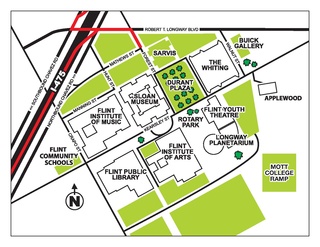
The Flint Cultural Center (FCC) is a campus of cultural, scientific, and artistic institutes located in Flint, Michigan, United States. The institutions located on the grounds of the FCC are the Flint Institute of Arts, Flint Institute of Music, Sloan Museum, Flint Public Library, Buick Gallery & Research Center, Robert T. Longway Planetarium, The Whiting, and the Bower Theatre. The campus and some institutions are owned by Flint Cultural Center Corporation.
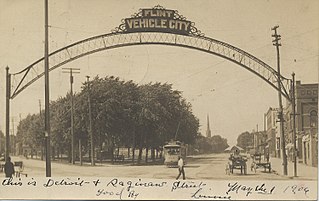
Flint, Michigan is a city which previously relied on its automotive industry, and still does to an extent. Over the past several decades, General Motors plants in Genesee County have experienced re-namings, management shifts, openings, closures, reopenings, and spinoffs.
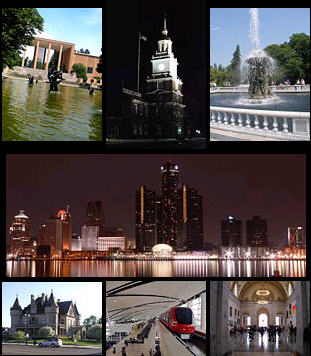
Tourism in metropolitan Detroit, Michigan is a significant factor for the region's culture and for its economy, comprising nine percent of the area's two million jobs. About 19 million people visit Metro Detroit spending an estimated 6 billion in 2019. In 2009, this number was about 15.9 million people, spending an estimated $4.8 billion. Detroit is one of the largest American cities and metropolitan regions to offer casino resort hotels. Leading multi-day events throughout Metro Detroit draw crowds of hundreds of thousands to over three million people. More than fifteen million people cross the highly traveled nexus of the Ambassador Bridge and the Detroit-Windsor Tunnel annually. Detroit is at the center of an emerging Great Lakes Megalopolis. An estimated 46 million people live within a 300-mile (480 km) radius of Metro Detroit.
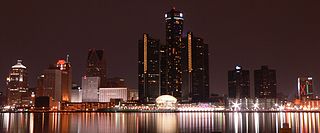
The metropolitan area surrounding and including Detroit, Michigan, is a ten-county area with a population of over 5.9 million, a workforce of 2.6 million, and about 347,000 businesses. Detroit's six-county Metropolitan Statistical Area has a population of about 4.3 million, a workforce of about 2.1 million, and a gross metropolitan product of $200.9 billion. Detroit's urban area has a population of 3.9 million. A 2005 PricewaterhouseCoopers study estimated that Detroit's urban area had a gross domestic product of $203 billion.
The Crim Festival of Races is an annual road running event with several races and walking events. The original distance was 10 miles and is the marque race as "The Crim" with its infamous Bradley Hills and blue line to keep runners on course. The Crim has been held in August in Flint, Michigan since 1977. It draws runners from around the world from countries such as Kenya, Russia, and Ukraine. The race attracts approximately 50,000 people each year. The festival is one of the Flint Parade of Festivals.
James W. Rutherford was a mayor of the City of Flint, Michigan serving as the first "strong" mayor elected under Flint's 1974 charter. Rutherford served for two terms. Rutherford was elected as a caretaker mayor after the recall of Mayor Stanley was recalled and an Emergency Financial Manager, Ed Kurtz, was appointed by the state.
Back to the Bricks is a car show held annually in Genesee County, Michigan.

Walt Disney's Riverfront Square was a planned theme park in St. Louis, Missouri that would have been the second Disney park, after Disneyland. The park was in development between 1963 and 1965.

Ontario Place was an entertainment venue, event venue, and park in Toronto, Ontario, Canada. The venue is located on three artificial landscaped islands just off-shore in Lake Ontario, south of Exhibition Place, and southwest of Downtown Toronto. It opened on May 22, 1971, and operated as a theme park centred around Ontario themes and family attractions until 2012 when the Government of Ontario announced that it would close for redevelopment. It has since reopened as a park without an admission fee but without several of the old attractions. The Government of Ontario has placed 145 acres on a 95-year lease with the Therme Group.

The Industrial Mutual Association Auditorium was an auditorium located at 815 East 2nd Avenue in Flint, Michigan.

Chevy Commons is a park along the Flint River between Kettering University and downtown Flint, Michigan. Formerly the site of a Chevrolet factory widely known as "Chevy in the Hole", it has been redeveloped and revitalized since 2015 as event space and recreational areas with restored grasslands, meadows, wetlands, and woodlands. It also features green spaces, low-maintenance native plants, and walking trails. In total, the creation of Chevy Commons is expected to cost approximately $17.3 million, and it is part of a broader, $36.8-million project to change the landscape of the Flint River in Downtown Flint. The state of Michigan has committed to developing the site as a state park.
The Industrial Mutual Association of Flint was a 501(c)(4) nonprofit organization whose focus was to benefit the workers and families of workers of General Motors.














